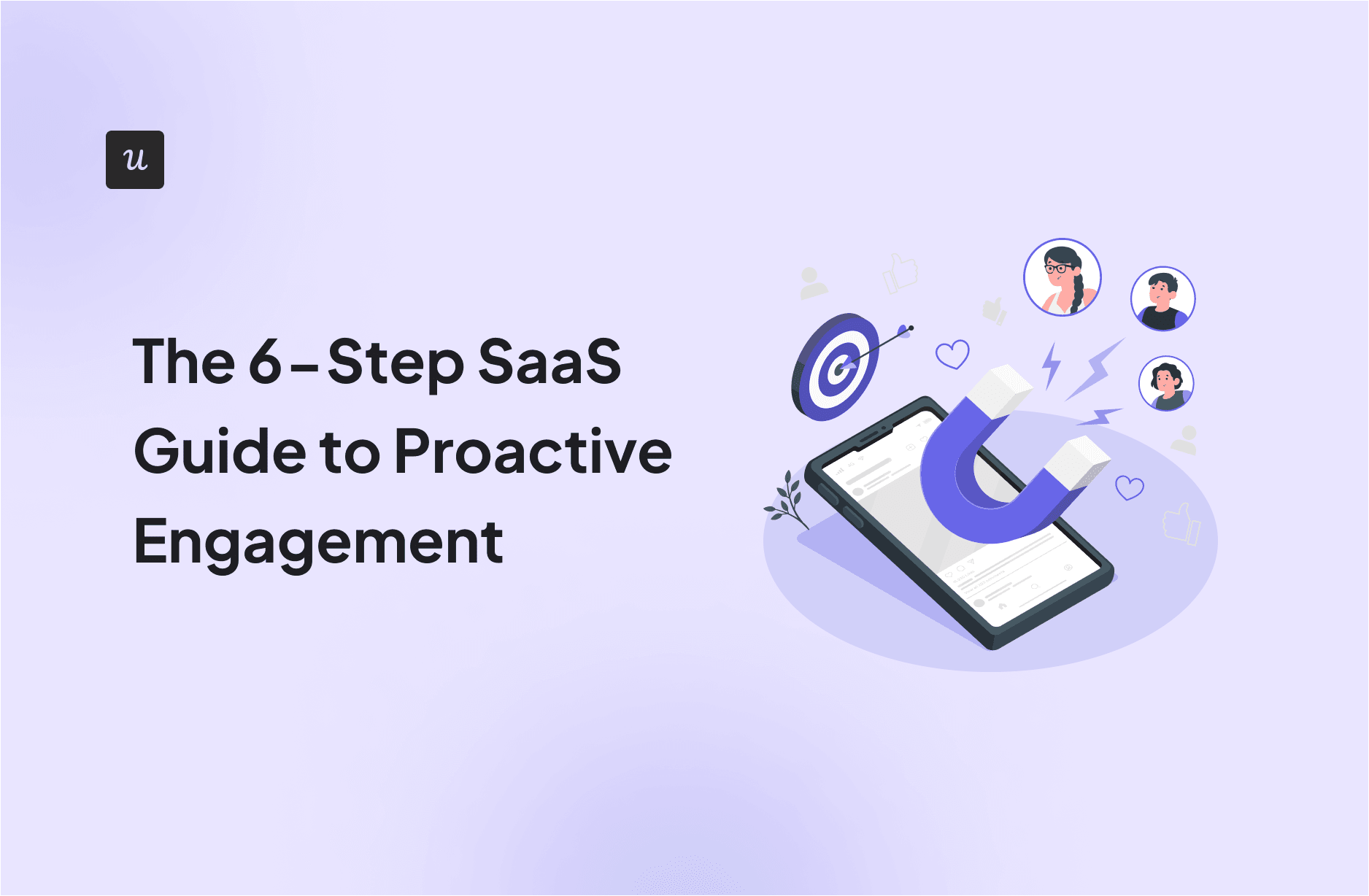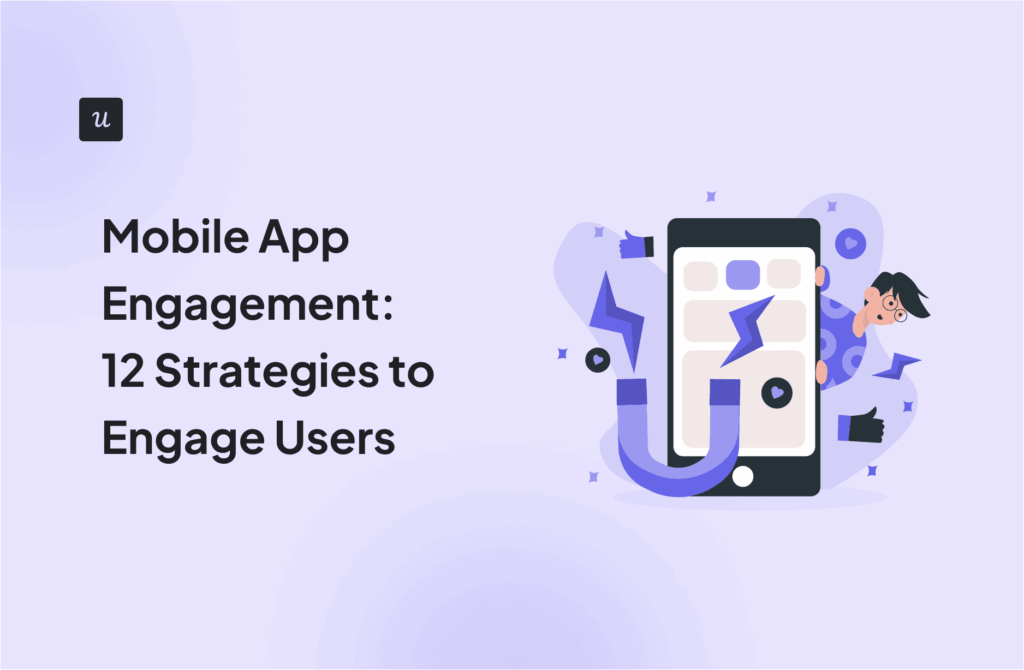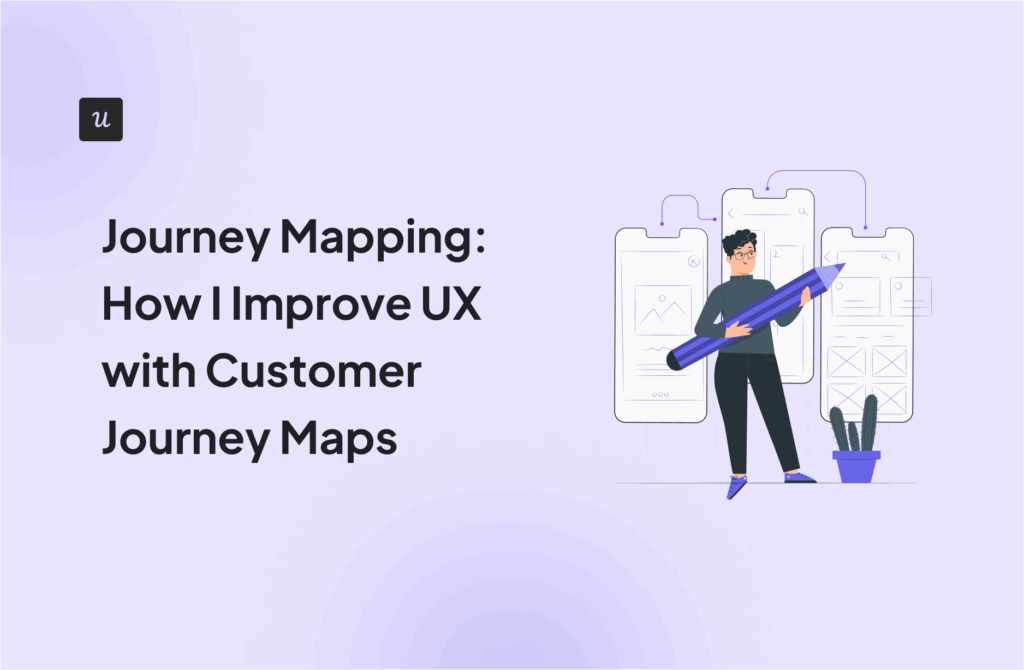
Do you know most companies lose 10% to 25% of their customers annually? Everyone agrees attrition is unavoidable, but the right proactive engagement strategies can help you delight customers and boost retention rates by a great margin.
Today’s post will provide a step-by-step guide to follow. For inspiration, we also included real-world examples from thriving SaaS companies.
Try Userpilot Now
See Why 1,000+ Teams Choose Userpilot

Customer service vs. proactive customer engagement: What’s the difference?
Though both approaches aim to improve the customer experience, they differ in how they achieve that goal.
Let’s start with some definitions.
Customer service is reactive engagement. It focuses on resolving problems and answering questions in a timely and helpful manner after a customer has encountered an issue or has a question.
For example, imagine a customer signs up for your SaaS product and needs help configuring a key feature. They search for help docs or video tutorials but find none, so they reach out to support and get the help they need. This is reactive because the customer had to initiate the interaction.
Conversely, proactive customer engagement is about anticipating customer needs and providing relevant solutions before they encounter problems.
Returning to our onboarding example above, proactive engagement would have meant creating interactive tooltips to provide contextual help before the new user even realizes they need it.
| Customer service | Proactive customer engagement | |
| Approach | Reactive | Proactive |
| Goal | Problem resolution | Relationship building |
| Timing | After an issue arises | Before an issue arises |
| Focus | Addressing immediate needs | Anticipating future needs |
| Communication channels | Phone, email, knowledge base, and other reactive channels | Live chat, contextual guides, and other channels for real time communication |
But don’t confuse proactive customer engagement with proactive customer service. Think of it this way: proactive engagement is like building friendships (sending birthday cards, remembering their favorite things), while proactive customer service is like preventing a fire before it starts (addressing issues before they become problems).
What are the biggest benefits of proactive engagement?
Not convinced that proactive customer engagement is a big deal? A Statista study found that 66% of customers favor brands that proactively engage with them. If you compare that with Gartner’s study, which shows only 13% of customers received proactive customer engagement, you’ll see a huge gap left to be filled—one that can quickly make your brand stand out.
Proactivity equips you to prevent churn, delight at-risk customers, and increase customer loyalty.
Here’s how:
Prevent churn with proactive outreach
Instead of just putting out fires, proactive engagement tactics ensure you shape the customer journey and guide users toward success.
For example, imagine you notice a customer hasn’t used a core feature since they signed up. Rather than waiting for them to become frustrated that they don’t find your tool useful, you can proactively reach out to understand why they aren’t engaging. Then, offer a personalized solution based on their needs. This shows you care about their success and reinforces the value of your product.
Identify and delight at-risk clients
At-risk clients aren’t always the ones voicing complaints. They’re often those quietly slipping away—showing less engagement, using fewer features, or contacting support less often.
Proactive engagement allows you to identify these individuals and turn their experience around. For example, using a tool like Userpilot, you can dig into specific customer profiles and view all their interactions since they began using your tool. If a power user submitted a support ticket months ago and their engagement has been on a steady decline since then, that’s your sign to reach out and try to re-engage them before they churn.
Turn frustration into customer loyalty
Dissatisfied customers always leave a trail of “hints” that, if addressed proactively, can become opportunities to build stronger relationships.
Here are some common signs of customer frustration and how to address them with proactive communication:
- Multiple support tickets in a short time: This suggests an unresolved issue and growing impatience. Consider triggering an automated message offering alternative resources or escalating the issue to a higher support tier.
- Low CSAT scores: Negative feedback in surveys indicates dissatisfaction. Flag these customers for high-priority support and personalized follow-up to understand their concerns.
- Decreased product usage: If a customer suddenly becomes less active, proactively reach out to check in on their experience and offer assistance.
- Social media complaints: Publicly aired grievances require a swift and visible response. Use your company’s social media account to acknowledge the issue, apologize, and offer a solution.
6 steps to enable a proactive engagement strategy
Excited to improve your overall customer experience and build better relationships? Let’s dive into the how-to:
1. Map the customer journey
Customer journey mapping is simply visualizing the customer’s experience from their perspective. Done well, it’s a critical first step that will help you understand customer needs, expectations, and potential pain points at each stage.
Aim to create a comprehensive map that covers the entire customer journey and highlights key touchpoints like website visits, signups, first logins, key feature usage, and more. This exercise makes it easier to pinpoint critical moments where proactive customer engagement can make a real difference.
Journey mapping can feel overwhelming if you’re doing it for the first time, but resources are available to help. Check out our guide on customer journey mapping for a step-by-step walkthrough. Tools like Userpilot can also simplify the process by helping you track in-app user behavior and collect direct customer feedback to understand each journey stage better.
Here’s a quick template to get you started creating your own customer journey map:

2. Segment your audience
To maximize the impact of your efforts, segment your audience into distinct groups with similar needs and behaviors. This allows you to tailor your proactive messages and interventions for greater relevance and effectiveness. Imagine trying to give the same advice to a brand new customer as a power user—it just won’t resonate the same way.
When segmenting, consider factors like demographics (age, location, etc.), purchase history (past purchases, average order value, etc.), engagement level (in-app activity, email opens, etc.), and customer lifecycle stage (new customer, loyal customer). Then, tailor your engagement strategies to each segment’s specific needs.
You can leverage Userpilot’s segmentation capabilities to create targeted user groups (e.g., inactive users) and trigger relevant experiences:

3. Create proactive onboarding flows for customer success
The initial user onboarding flow is often your most significant opportunity to demonstrate value and drive long-term engagement.
A few tips to make it great:
- Personalize the experience from the get-go: For example, you could use a welcome survey to collect customer data like name, jobs-to-be-done, company size, etc., and then use that information to tailor your onboarding flow.
- Trigger interactive guides: Why use bland tours when you can make them interactive and keep users hooked through the process?
- Emphasize product value: Don’t just list features. Ensure your flows show users how the product can help them drive real business value (or whatever their core objective for using your tool is).
Don’t just take our word for it: See how Attention Insights utilized Userpilot to implement these tips and boost their engagement rates:
4. Create valuable content and provide relevant information
Develop an extensive content strategy that addresses various customer needs and learning styles.
This could include in-app messages, insightful blog posts on industry trends, detailed knowledge base articles covering FAQs and troubleshooting, engaging webinars exploring advanced features, and inspiring case studies showcasing customer success stories. The key is to make this information readily available and easily accessible.
From in-app messages to interactive resource centers, Userpilot can help you create engaging content experiences for different user groups.
Here’s an example:

5. Automate your customer conversations
While personalized, one-on-one interactions are valuable, scaling proactive engagement often requires automation.
Leverage chatbots, email sequences, and in-app messages to automate routine tasks and provide instant support.
For example, you can utilize Userpilot to trigger welcome messages for new customers, create feature announcement modals to communicate new releases, deliver intuitive tooltips for in-app guidance, etc.

6. Gather customer feedback and iterate!
Continuously collect customer feedback through surveys, in-app messages, and support interactions. This will create a healthy feedback loop that allows you to adapt and improve your proactive engagement strategy.
With a tool like Userpilot, you can easily create NPS, CSAT, CES, and other forms of in-app surveys. Moreover, Userpilot can automatically analyze your survey results and provide actionable insights to enhance the customer experience.

What are some examples of proactive customer engagement?
This section will cover a few examples to show you how successful SaaS companies approach proactive customer engagement.
1. Userpilot deploys a resource center for self-service
What Userpilot does well: The resource center is enriched with tutorial videos, onboarding flows for customers who might need a refresher about how some features work, webinars, case studies, and even a link to chat directly with support. All these make it easy for customers to resolve issues on their own.
Key takeaway: A comprehensive resource center reduces support tickets and enhances customer happiness. While you can have this on your website, incorporating it into your web app is better because it means customers don’t have to switch between tabs when they run into a problem.

2. Slack uses automated chatbots to strengthen customer relationships
What Slack does well: Slack’s built-in chatbot proactively assists users with tasks, provides guidance, and answers questions related to Slack or the channel in question. As in the example below, companies can customize the bot to fit their needs and streamline workflows.
Key takeaway: Use chatbots to automate routine tasks, provide instant support around the clock, and improve customer satisfaction. This allows your human agents to focus on higher-value interactions and build stronger customer relationships faster.

3. Loom proactively encourages users to record their first video
What Loom does well: Loom makes an intentional effort to guide users toward experiencing the product’s core value—video recording— as quickly and easily as possible. Their landing page provides a clear call to action that leads users to install the tool. Once inside, Loom delivers helpful tips within the product interface to get users up to speed quickly.
Building a Chrome extension was also brilliant, as it allows users to easily record videos from anywhere on the web.
Key takeaway: Make it as easy as possible for users to experience your product’s core value early on. This will help them quickly understand the benefits and increase the likelihood of them becoming active and engaged users.

4. Dock provides a centralized workspace for sales teams and clients
What Dock does well: The centralized hub simplifies communication and ensures customers have everything they need in one place. This eliminates the need for scattered emails and attachments, ultimately tying back to the platform’s value proposition of helping users “win sales deals & onboard customers in one space.”
Key takeaway: Where possible, try to provide customers with a single source of truth for all relevant information. Use automation to keep them informed and engaged, proactively delivering updates and reminders within the centralized workspace.

Proactive engagement strategy: Best practices
Embellish your customer engagement strategy with gamification, social media engagement, and predictive analysis. These three best practices will help you maximize customer interactions and drive high retention rates.
Let’s discuss them in detail:
Experiment with gamification to create a reward structure for customers
Gamification taps into our natural desire for achievement and rewards. However, not all game-like elements will move the needle for your users—you’ll need to consider factors like demographics, journey stage, and the nature of your product.
Here are a few ideas that generally work for SaaS:
- Use a 3-5-point checklist to help users complete tasks quickly.
- Include a progress bar when there are many tasks or users have to wait for page elements to load.
- Provide relevant rewards for completing milestones like signing up, finishing an onboarding flow, etc. For example, you could reward trial users with extra days on your app if they complete your onboarding process within X days.

Engage with customers on social media
Don’t just wait for customers to contact you—actively seek out opportunities to provide value and build relationships. This could involve monitoring social media for mentions of your brand or industry and proactively joining relevant conversations (webinars, online forums, etc.).
You could also find opportunities to deliver valuable insights, answer questions, or offer solutions, even if the discussions aren’t directly about your business.
Remember to meet customers on their preferred communication channels. If your target audience is primarily on LinkedIn, focus your efforts there instead of spreading yourself thin across every platform.
Leverage predictive analytics to anticipate customer needs
Predictive analytics uses data to anticipate future outcomes and customer behaviors.
By analyzing customer demographics, purchase history, in-app activity, support interactions, and social media engagement, you can identify potential needs and proactively offer solutions or recommendations. This level of personalization creates a sense of anticipation and demonstrates that you understand your customers’ preferences.
Userpilot comes in handy here. Our customizable analytics dashboard allows you to track your key engagement metrics in one place and easily spot behavior trends and patterns:

Conclusion
Proactive customer engagement helps you avoid the frustration and churn that often result from reactive customer service. By implementing the strategies and best practices we’ve discussed, you can create positive customer experiences that improve satisfaction, build stronger relationships, and ultimately drive business growth.
Looking for an all-in-one platform to help you implement proactive engagement strategies? Userpilot offers a comprehensive suite of tools to track customer data, segment your audience, and automate personalized interactions. With features like in-app guidance, targeted messaging, and advanced analytics, Userpilot can empower you to create truly engaging experiences that drive customer success. Book a personalized demo with our team to get started today!















